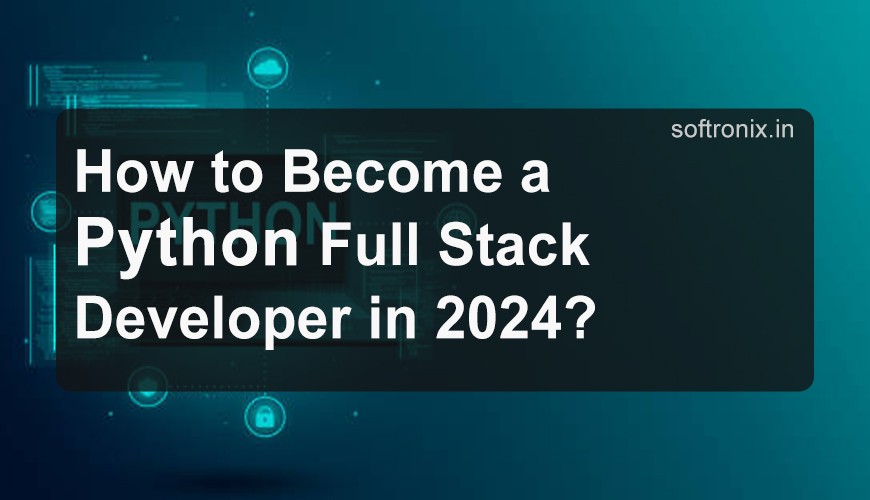
How to Become a Python Full Stack Developer in 2024?
Python's prominence is soaring, and full stack abilities are popular. In any case, where do you begin? Simply relax, we take care of you. In this blog, we'll walk you through the moves toward changing yourself into a Python Full Stack pro. From dominating Python basics and bolts to conquering web structures and databases, we'll separate everything for you. Whether you're a coding beginner or hoping to step up your abilities, this guide will assist you with exploring the interesting universe of full stack development. Prepared to make a plunge? We should get everything rolling!
Skills Needed to Become a Python Full Stack Developer
Ready to dive into the universe of Python full stack development? You'll have to pack your toolkit with different abilities. How about we separate it for you?
Master Python
First things first, you've got to become besties with Python. It's the backbone of your full stack journey! Get comfy with its syntax, data structures, and object-oriented programming concepts. Don't forget to explore popular Python frameworks like Django and Flask – they'll be your trusty sidekicks.
Frontend Fundamentals
You can't call yourself a full stack dev without some front-end artfulness. Look out for any way to improve on your HTML, CSS, and JavaScript abilities. These are your building blocks for creating slick user interfaces. And hey, why not throw in some React or Vue.js for good measure? They're hot commodities in the dev world.
Database Knowhow
Backend wizardry is incomplete without database magic. Get your hands dirty with SQL and NoSQL databases. PostgreSQL, MySQL, or MongoDB - choose the evil! Understanding how to store, recover, and control data is significant for any Full Stack Python Developer deserving at least some respect.
Version Control and Deployment
Git is your new best friend. Figure out how to track changes, team up with others, and deal with your codebase like a genius. Also, with regards to deployment, find out more about cloud platforms like AWS, Google Cloud, or Heroku. They'll help you take your projects from your local machine to the World Wide Web.
Remember, becoming a Python full stack developer is a journey. Keep learning, keep coding, and most importantly, have fun with it!
Choosing the Best Python Fullstack Training Institute
Hey there, future Python full stack developer! Let's chat about how to pick the perfect Python Fullstack training institute for your journey.
Look for Hands-on Experience
First things first, you want a place that's all about getting your hands dirty with code. Theory's great and all, but nothing beats real-world experience. Look for institutes that offer plenty of projects and practical assignments. You'll thank yourself later when you're crushing those job interviews!
Check Out the Curriculum
Make sure the institute covers all the bases. You're aiming for a full stack, remember? So, you'll want to see front-end techs like HTML, CSS, and JavaScript, plus back-end stuff like Django or Flask. And don't forget about databases and version control!
Instructor Quality Matters
Who's teaching you can make or break your learning experience. Look for institutes with experienced instructors who've been in the trenches. Bonus points if they're still active in the industry!
Consider Softronix Classes in Nagpur
If you're in or near Nagpur, you might want to check out Softronix Classes. They've got a solid rep as a Python Fullstack training institute in nagpur. But hello, have little to no faith in us - get your homework done and check whether it meets your prerequisites.
Remember the best institute is the one that lines up with your targets and learning style. Take as much time as the need might arise, take a look at choices and options, and focus on your gutty feelings. You've got this!
Building a Portfolio as a Python Full Stack Developer
As a growing Full Stack Python Developer, your portfolio is your purpose in life card. It's not just about displaying your abilities — it's tied in with recounting your coding story. We should jump into how you can build a portfolio that will cause possible bosses to pay attention.
Showcase Your Full Stack Prowess
First things first, you'll want to highlight projects that demonstrate your full stack capabilities. Think about creating a personal website or blog using Django or Flask for the backend, and spice it up with some slick frontend work using React or Vue.js. This shows you can handle both ends of the development spectrum like a pro.
Diversity is Key
Try not to tie up your things in one place. Include a blend of tasks that showcase parts of full-stack development. Maybe a RESTful API here, a database-driven app there, and throw in a mobile-responsive design for good measure. This variety simply proves you're not a one-trick pony.
GitHub is Your Best Friend
Make sure your GitHub profile is up to snuff. It resembles your coding résumé, so keep it clean and dynamic. Add to open-source projects, push your code routinely, and remember to write clear, compact READMEs for each project. Everything revolves around showing you can play well with others in the coding sandbox.
Tell Your Story
Keep in mind your portfolio isn't simply a collection of code — it's a hardworking story of your journey as a developer. Incorporate a brief bio, explain your passion for Python full stack development, and don't be shy about sharing your growth experiences. Authenticity can be similarly just as noteworthy as technical abilities.

0 comments